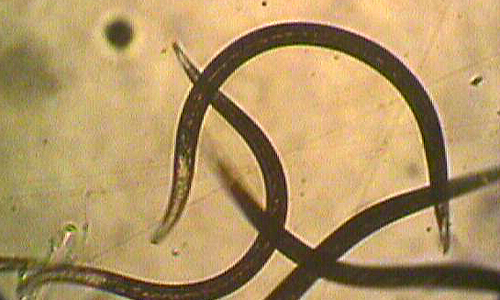Strawberry root weevils
Importance of strawberry root weevils
Strawberry root weevils, Otiorhynchus ovatus are considered as one of the most economically important insect pests of strawberry crops because both of their adults and larvae cause a serious damage to foliage and roots of strawberries, respectively causing millions of dollars loss to a strawberry industry.
Facts (show all)
- Taxonomy and list of the most economically devastating species of strawberry root weevils
-
- Common name: strawberry root weevil.
- Scientific name: Otiorhynchus ovatus
- Kingdom: Animalia
- Phylum: Arthropoda
- Class: Insecta
- Order: Coleoptera
- Family: Curculionidae
- Subfamily: Entiminae
- Genus: Otiorhynchus
- Species: O. ovatus
- Identification of strawberry root weevils
-
Adults: Adults of strawberry root weevil are small about 0.25-inch long, shiny, brown to blackish in color with mouthparts extended into a snout. Adults are difficult to detect during daytime because they are active only during night and hide in the upper layer of soil during day.
Eggs: Eggs of strawberry root weevil are about 0.025 inch long and round in shape. Freshly laid eggs are whitish in color but they turn brownish just before hatching.
Larvae/grubs: The mature larvae of strawberry root weevil are legless, about 5-6 mm long, “C” shaped and creamy white in color.
Pupae: Pupae of strawberry root weevil are whitish in color.
- Biology of strawberry root weevils
-
Larvae of strawberry root weevils overwinter in the soil where it continue feeding on strawberry roots. Early in the spring larvae becomes more active and pupate in the soil in June. After mating, females lay yellow eggs on the surface of soil or in the soil. Eggs hatch into small larvae (grubs) within one week. After hatching from eggs, tiny larvae immediately start feeding on the roots and become mature within 3 weeks by passing through four developmental stages. Matured larvae then move into soil for overwintering in the soil. Strawberry root weevils take 2 years to complete lifecycle.
- What type of damage is caused by strawberry root weevils?
-
All the four larval stages of strawberry root weevil feed on the roots. While feeding they can prune roots or tunnel into the roots and the crowns. Of the four larval stages, third and fourth larval stages are most damaging to strawberries than in the spring. The main symptoms of damage caused by larvae of strawberry weevils include weakening, stunting and eventually killing of strawberry plants. Adults of strawberry root weevil commonly feed on the edges of strawberry leaves and cause leaf notching. During hot and dry weather conditions adults of strawberry root weevil also enter into houses. When inside the house they can be nuisance to people but not harmful. Home-invaded strawberry adults also do not cause any type of damage to ether wood or any other house structure.
- Biological control of strawberry root weevils
-
Biological control agents including beneficial entomopathogenic nematodes and carabid beetles, Pterostichus vulgaris are very safe and effective alternatives to chemical insecticides in controlling strawberry root weevils because they are not harmful to humans, children, pets, birds as well as beneficial insects. Both naturally occurring and inundatively applied beneficial entomopathogenic nematodes in the soil can find, infect and kill soil dwelling mature larval, pre-pupal and pupal stages of straberry root weevils. For example, both mature larva and pupa of strawberry weevil live in the soil so they are a very good target for beneficial entomopathogenic nematodes. Beneficial entomopathogenic nematode species including Steinernema carpocapsae and Heterorhabditis bacteriophora have shown a very high efficacy against larval and pre-pupal stages of strawberry root weevils. Both of these nematode species are commercially available and can be applied at the rate of 1 billion nematodes per acre for the effective control of strawberry root weevils.
- Beneficial predatory insects that are effective against strawberry root weevils
-
- Carabid beetles, Pterostichus vulgaris
- Beneficial entomopathogenic nematodes that are effective against strawberry root weevils
-
- Heterorhabditis bacteriophora
- Steinernema carpocapsae
- Research Papers
-
Booth, S.R., Tanigoshi, L.K. and Shanks, C.H. 2002. Evaluation of entomopathogenic nematodes to manage root weevil larvae in Washington state cranberry, strawberry, and red raspberry. Environmental Entomology 31: 895-902.
Simser, D. and Roberts, S. 1994. Suppression of strawberry root weevil, Otiorhynchus-ovatus, in cranberries by entomopathogenic nematodes (Nematoda, Steinernematidae and Heterorhabditidae. Nematologica 40: 456-462.
Vainio, A. and Hokkanen, H.M.T. 1993. The potential of entomopathogenic fungi and nematodes against Otiorhynchus-ovatus L and O. dubius strom (Col, Curculionidae) in the field. Journal of Applied Entomology-Zeitschrift fur Angewandte Entomologie. 115: 379-387.




